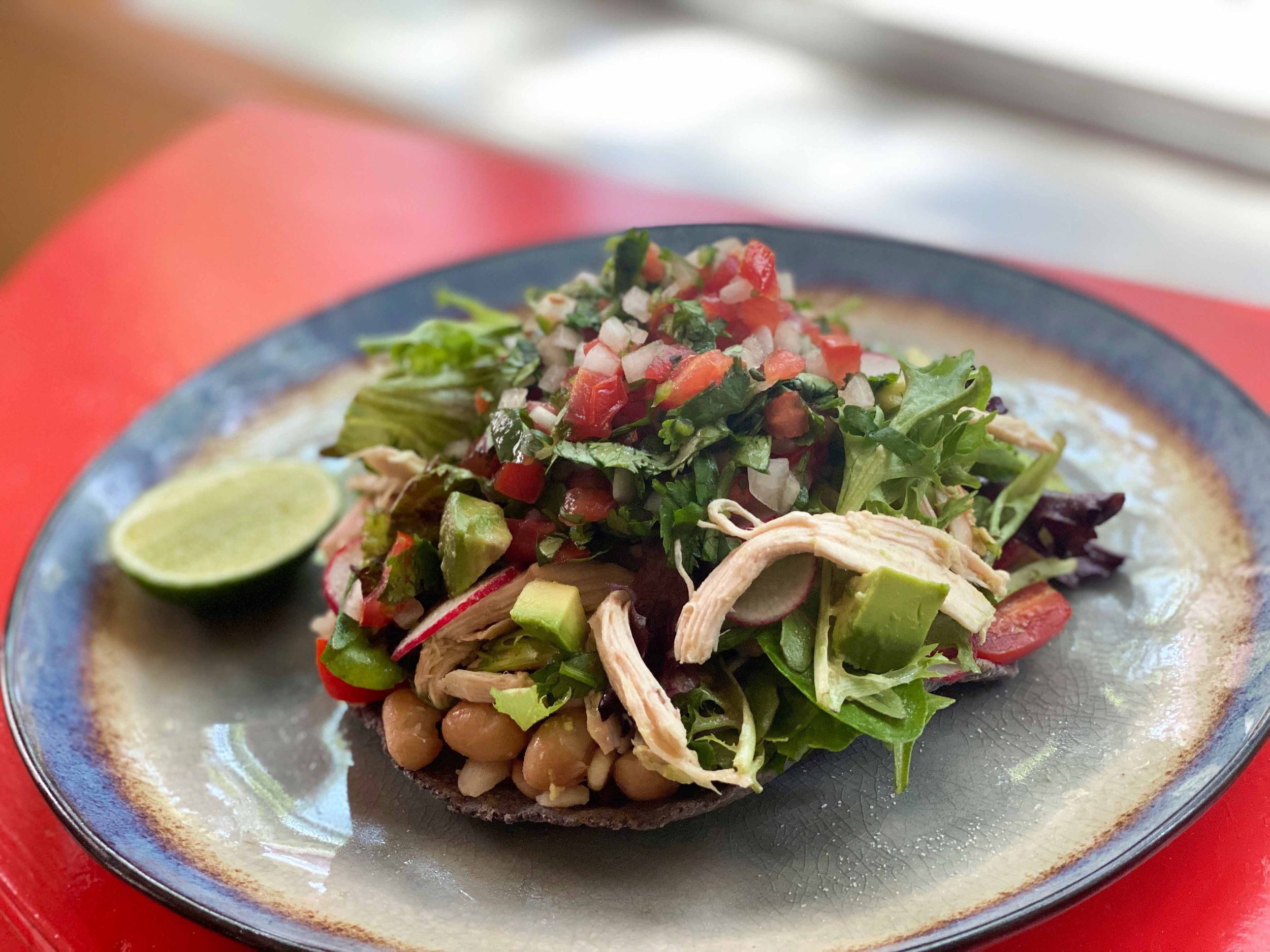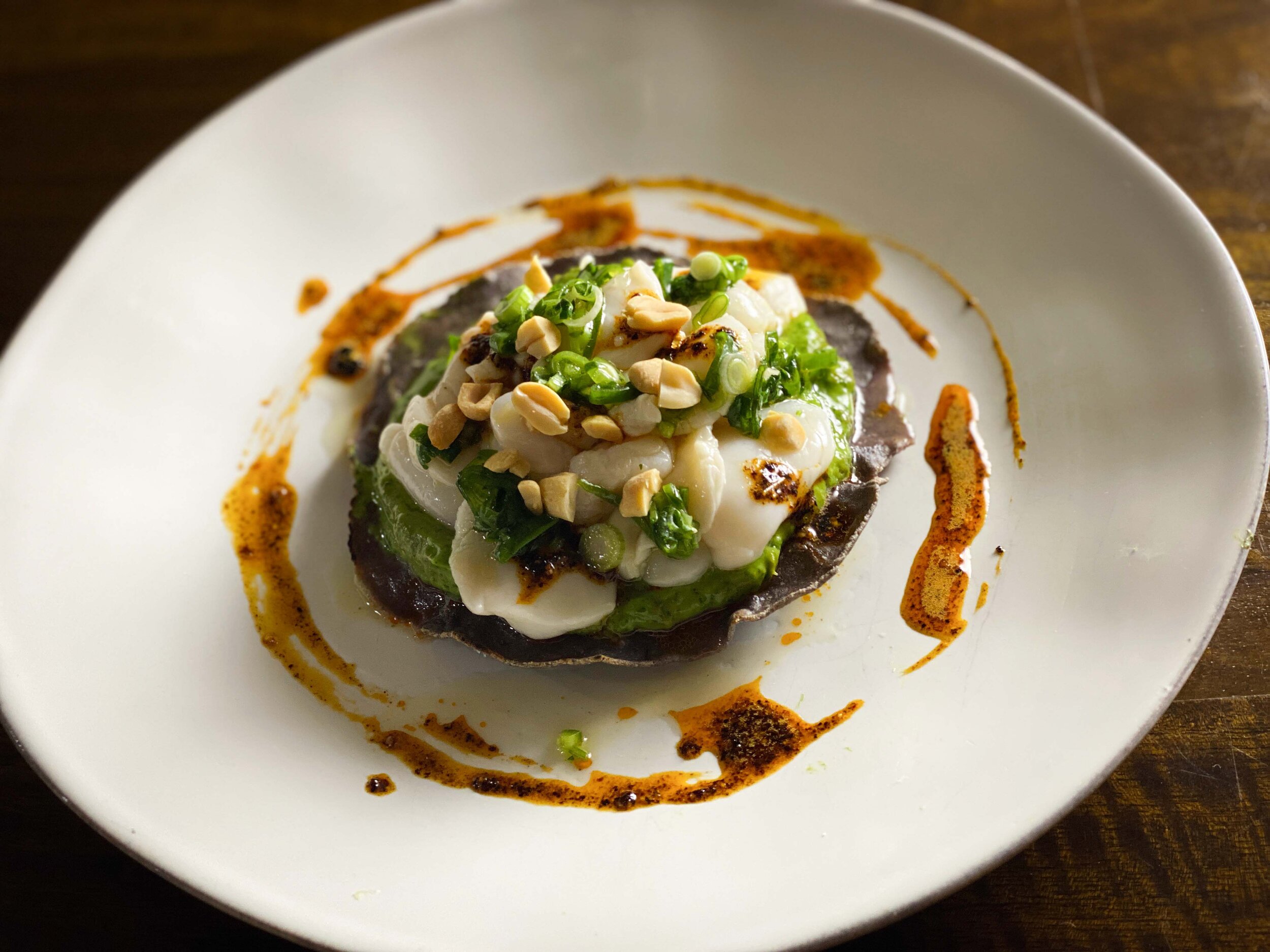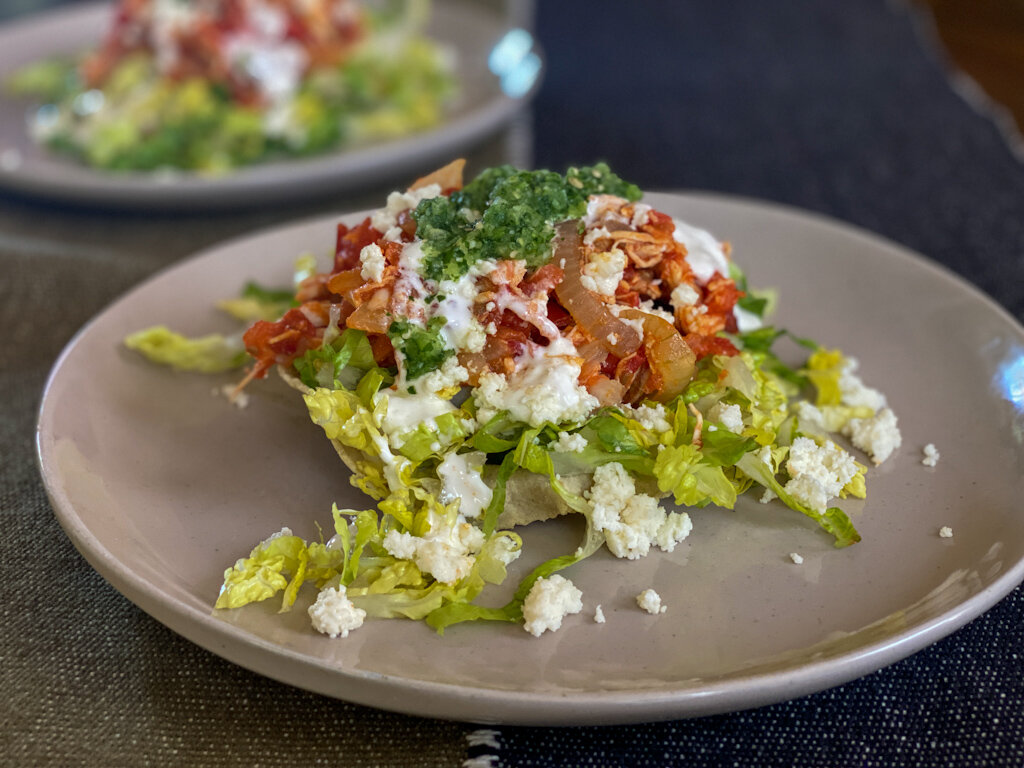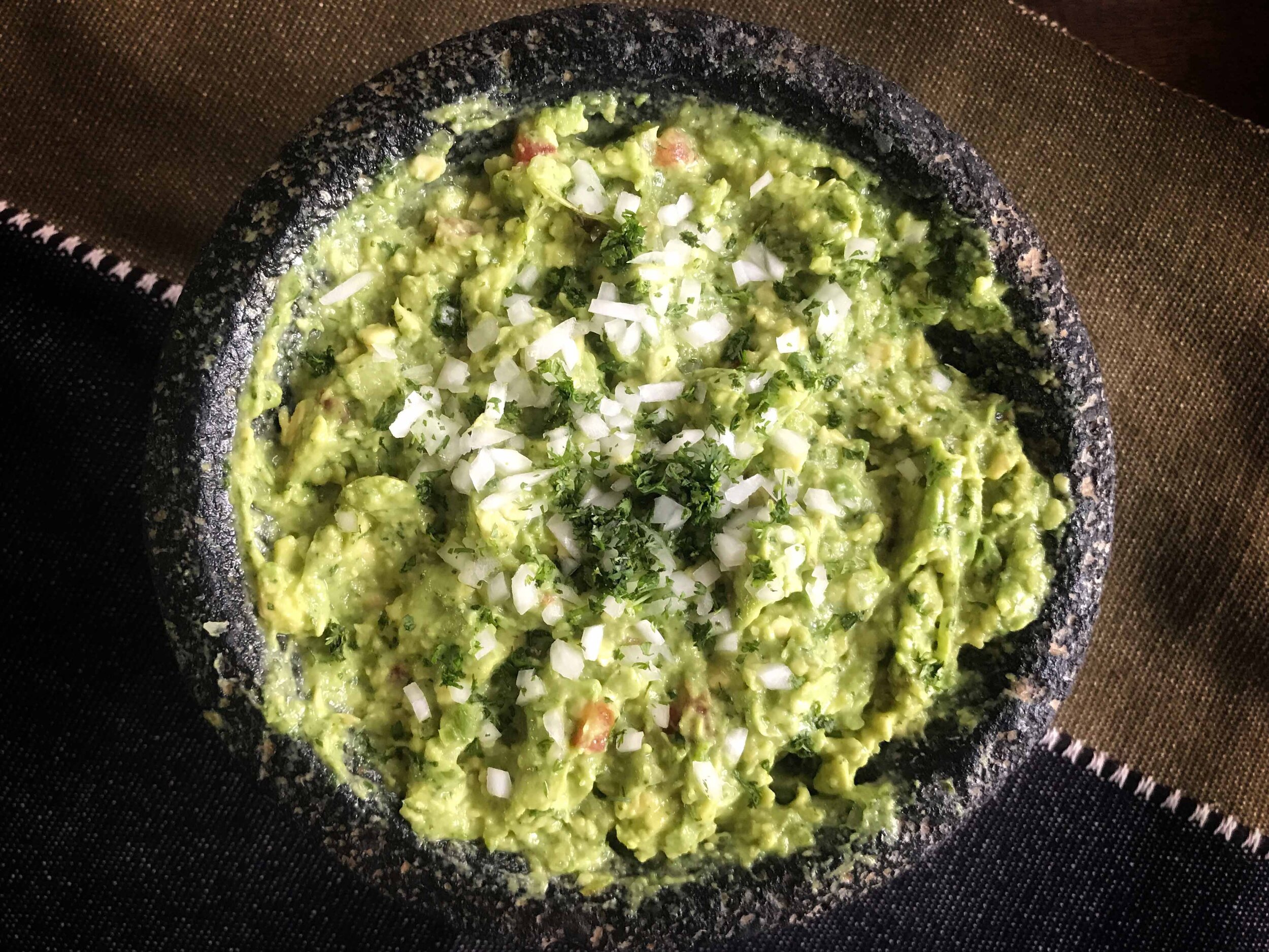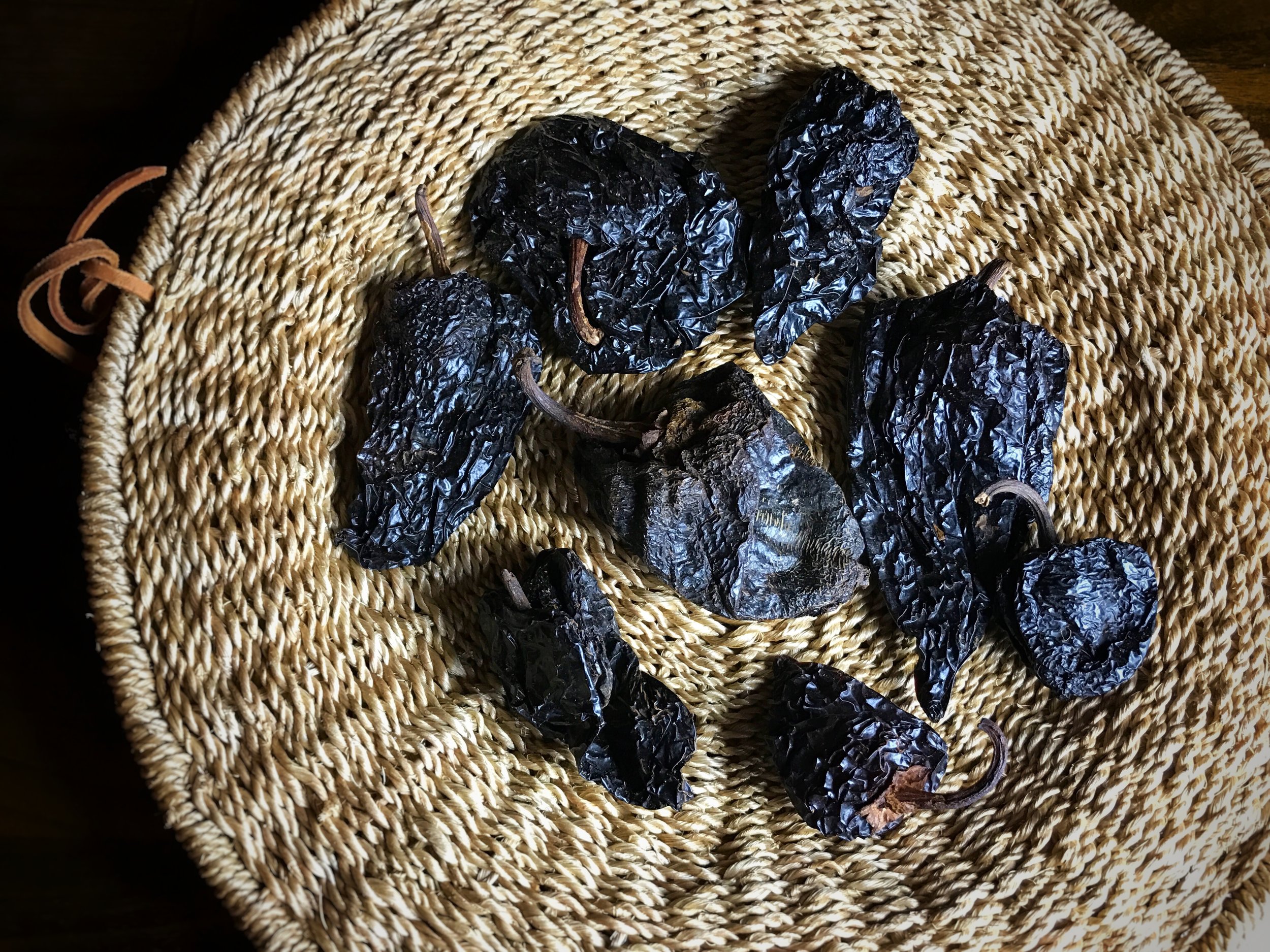An heirloom-corn tostada topped with beans, salad, shredded chicken and pico de gallo
By Leslie Brenner
Why doesn’t everyone eat tostadas, all the time? It’s a question that nags me noon and night — especially in summertime, when the idea of something light, healthy and fresh, but also delicious and satisfying (and gluten-free!), is top of mind. Plus they’re infinitely adaptable.
What is a tostada? It’s a crisp corn tortilla topped with something appealing. It could be a cold, inviting ceviche. It might be a fresh salad with a layer of warm beans. Perhaps it’s a thatch of cool shredded lettuce topped with warm tinga de pollo. Or an irresistible spin on avocado toast. Whichever way, the tortilla underneath provides delightful crunchy contrast.
People in Mexico, where tostadas were invented, understand their terrific appeal.
And tostadas have been a thing in Southern California for ages. When I was growing up in Los Angeles, giant salady chicken tostadas layered with beans were found in just about every Mexican restaurant: the perfect lunch. My favorite version, as a young adult working in Hollywood, was conveniently located across the street from Paramount Studios, at a show-biz hangout called Lucy’s El Adobe. But you could find chicken tostadas everywhere.
More fashionable these days in the Golden State — and differently wonderful — are simpler, flatter seafood tostadas topped with things like ceviche or octopus salad. A stall in downtown L.A.’s Grand Central Market called La Tostaderia specializes in them, but they’re also found on mariscos (seafood) trucks and stands all over town.
“Places like that are all over Mexico,” says Olivia Lopez, owner of Molino Olōyō in Dallas, and Cooks Without Borders’ Mexican cuisine expert. Known as marisquerías, they are small spots selling mariscos, often arrayed on tostadas. They are popular in Colima, the coastal state where she’s from, and all along the Pacific coast. And they’re trending. “Marisquerías are expanding all over the country,” says Olivia. “It has become a trend in maybe the last 10 years.”
Bright, light, fresh and tangy, a tostada makes an irresistible lunch or snack. Dress it up a bit, and you can invite it to a special dinner. Or tostada party, which Olivia has done recently at a couple of pop-ups.
Yep — Olivia knows how to dress them up. On Molino Olōyō’s Instagram feed, you’ll find one topped with pickled cabbage, chicken in mole, homemade crema, pickled onions and salsa macha.
I fell head-over-heels in love with her Scallop Ceviche Tostada the minute I laid eyes on it, and even more when I tasted it. It’s a blue-corn tostada spread with avocado purée, topped with a bright and voluptuous scallop ceviche and drizzled with a tangy Scallion Condiment. Salsa macha is spooned around, adding depth, and crunchy toasted peanuts go on top.
It’s cheffy and gorgeous, to be sure, but surprisingly easy to achieve at home. Especially if you happen to keep a jar of Olivia’s outstanding Salsa Macha in the fridge, and you’ve made the tostada bases in advance. The scallop ceviche itself is a snap to make; it takes all of about 10 minutes.
Do try this at home
Before heirloom masa harina changed my life, I never made tostadas at home. But now that it’s remarkably easy to make outstanding corn tortillas that don’t involve GMO corn, I make them all the time. It’s a no-brainer — and no need to fry the tortillas to get the crunch. Just make a batch of tortillas, set them on a rack on a baking sheet and let them dry out and get crisp in a low oven. Alternatively, you can use leftover tortillas — simply dry them in the oven.
Then let your imagination go wild.
As a starting point, you might use avocado on top of the crisped tortilla. Olivia’s scallop ceviche creation uses avocado purée, but you could also smear some guacamole or smashed avocado on there, or dress it up like an avocado toast — pretty slices, a generous squeeze of lime, some fancy salt and a grind of black pepper or smattering of chile flakes. In full-on summer, juicy slices of heirloom tomato are a delightful addition. Cilantro leaves are always welcome.
I love the simple treat, because it really features the fabulous, deep flavor of the heirloom corn tortilla — and it’s also vegan and gluten-free.
You don’t need a recipe for it, but here’s a recipe anyway.
A Mexican home-cooking classic
If you’re a fan of Chicken Tinga (Tinga de Pollo) — an easy stew of poached chicken, tomato, onion, garlic and chipotle chile — you can do as Mexican home cooks do and make second-day Tostadas con Tinga de Pollo with the leftovers. Just spoon some reheated Chicken Tinga over a tostdada piled with shredded lettuce, garnish with crumbled queso fresco, if you like, and maybe a squiggle of crema (Mexican sour cream). Bright-flavored raw salsa verde adds tangy dimension.
Or join me in reliving my youth and construct an addictive Chicken Salad Tostada.
Last summer, I got in the habit of keeping tostadas handy, along with the makings of pico de gallo (tomato, white onion, serrano, cilantro) and avocados, and on the weekend I’d make a pot of frijoles de olla. Using organic roast chicken picked up at the supermarket (don’t tell my kid!), I found myself making these a couple times a week. I also stared keeping cans of organic pinto beans around, in case I needed to have this and didn’t have time to make beans. (Yes, they’re that crave-able!)
This summer (which hasn’t even officially started yet) is shaping up to be a repeat.
When you make them, they look giant. The salad spills over the tortilla. You think, that’s so big — how can I possibly eat that? You can; it’s mostly lettuce. The contrast of its cool freshness with the rich, warm beans is marvelous. The avocado and chicken make it substantial. The pico de gallo makes it superbly juicy and bright.
In other words, buen provecho: I hope you enjoy my favorite lunch!
Want to receive our recipes in your in-box? Sign up for our free newsletter.
If you enjoyed this story, you might like:
“Salsa Macha is the hottest condiment of the year, and we’ve got the best recipe”

